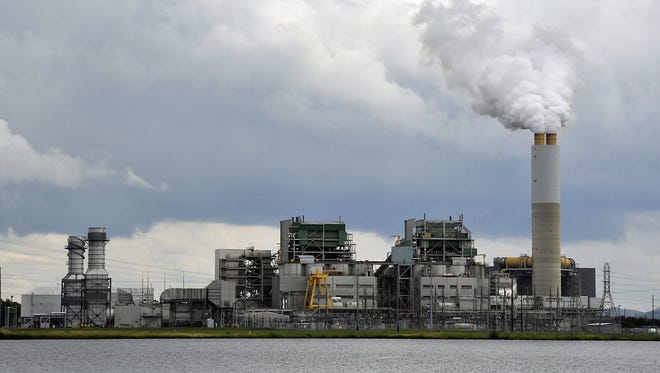What Comes Out of Coal Power Plant Stacks

Today's batch of burning questions, my smart-aleck answers and the real deal:
Question: I know the Duke Energy coal-fired power plant at Lake Julian is going to switch to natural gas in 2019, but can you tell us the makeup of what's currently in the 'smoke' coming from the smokestack? Also, how much cleaner will the exhaust be once it is converted?
My answer: Really, it's just butterfly burps and sparrow toots in that exhaust. Completely harmless. Let's move on.
Real answer: So, this has been a recurring-theme question. Undoubtedly, what comes out of that stack is mostly steam, and it is way cleaner than 20 years ago.
But it's not pure and harmless, either. So I checked with Duke Energy and environmental groups to get both sides.
Duke Energy spokeswoman Heather Danenhower noted that people "thinking this is smoke is a common misconception.
"The 307-foot stack at the Asheville site expels water vapor similar to fog," she said. "The Asheville coal-fired plant has pollution-control equipment, installed in 2006 and 2007, which limits emissions. The plant also operates in compliance with all permit requirements."
MORE: Duke Energy agrees to pay $84K penalty for coal ash leaks
The plant will switch to natural gas in 2019, and that will result in cleaner burning fuel. Danenhower noted that the new 560-megawatt combined-cycle natural gas plant "will operate about 35 percent more efficiently than the exiting coal units."
As you may have guessed, it's tough to burn coal without creating pollutants.
"The new plant will reduce carbon dioxide emissions by about 60 percent (per-megawatt-hour), decrease sulfur dioxide by 90-95 percent, reduce nitrogen oxide by 35 percent, lower water withdrawals by about 97 percent, reduce water discharges by half and completely eliminate mercury," Danenhower said.

Now, keen readers may ask, Well, how can all that stuff be reduced and eliminated if it's just fog coming out of the stack?
That's why I checked with environmental folks.
"On the one hand they're saying, 'We emit no pollutants,' but on the other they're saying, 'But don't worry — it's going to get a lot better real soon,'" said D.J. Gerken, managing attorney, with the Southern Environmental Law Center's Asheville Office. "It's true that the plant emits a lot of steam, but it is false to say they're not emitting a lot of air pollutants. They absolutely are."
Dave Rogers, the North Carolina representative for the Sierra Club's Beyond Coal campaign, said, "It's fair to say the plant is cleaner than it was 20 years ago, but it's not honest to say the plant is clean; that it's fog."
MORE: Hiring our heroes: A wise choice for businesses
The controls have greatly reduced emissions.
"(But) those controls seek to limit, not eliminate, pollutants," Rogers said. "Most of what people see is water vapor, but nitrous oxide, sulfur dioxide, mercury — those are still coming out, just at lower levels than they were. And carbon dioxide is not regulated at all, so there's no change in that."
Carbon dioxide doesn't have a direct impact, like mercury does on the local area, but it does "contribute significantly to global warming," Rogers added.
Bridget Lee, staff attorney with the Sierra Club's Environmental Law Program, said Duke has not been operating the scrubbers at full power.
"Despite having installed equipment designed to reduce air pollution from its Asheville coal plant, Duke has not operated the equipment fully and has allowed harmful emissions of sulfur dioxide — exposure to which can cause asthma attacks and other respiratory health problems — to escape out its smokestacks," she said. "A study of those emissions showed that the plant caused air pollution at concentrations higher than EPA's air quality standard. Without a tighter numeric limit on those emissions, people living near the plant cannot be sure that the air the breathe is safe."
When I last wrote about this in January 2016, a Duke official noted that since 2005, the scrubbers at the Lake Julian plant had reduced sulfur dioxide emissions there by more than 95 percent.
That's good news, but sulfur dioxide wasn't eliminated, and it is a dangerous respiratory irritant.
A Sierra Club study at the time found that the worst pollution from the plant's emissions was concentrated in residential and recreational areas, such as the Bent Creek hiking area around Buncombe County.
So, the natural gas plant will definitely be better for the environment.
Let's just not bring up fracking.
This is the opinion of John Boyle. Contact him at 232-5847 or jboyle@citizen-times.com
What Comes Out of Coal Power Plant Stacks
Source: https://www.citizen-times.com/story/news/local/2018/01/18/answer-man-does-duke-energy-smokestack-pollute-just-steam/1043609001/